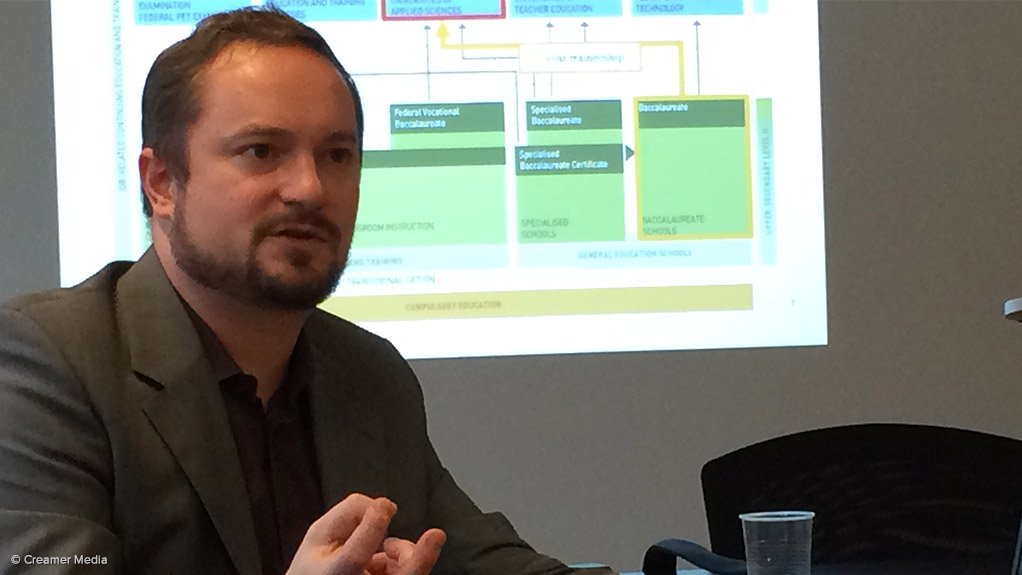Balance key to a working education system


Swiss State Secretariat for Education, Research and Innovation international cooperation in education project manager Jérôme Hügli
Photo by Leandi Kolver
Balance was the key to a working education system, as both practically or vocationally trained workers and those with academic qualifications were needed to fulfil a country’s needs, Swiss State Secretariat for Education, Research and Innovation international cooperation in education project manager Jérôme Hügli, said this week.
Addressing a South Africa delegation to Switzerland, including government, business and training institution representatives, as well as members of the media, he explained that such a balanced system, as was used in Switzerland, was believed to contribute to a lower youth unemployment rate as youth learnt the skills that were relevant to the economy at that stage.
As of 2013, Switzerland had an unemployment rate of 3.2%, with its youth unemployment rate – persons aged 15 to 24 – only being slightly higher at 3.4%.
Meanwhile, according to Statistics South Africa’s third quarter Quarterly Labour Force Survey, South Africa’s unemployment rate was currently 25.5%, with 67.5% of the total unemployed being between 15 and 34 years of age.
Hügli explained that vocational training in Switzerland was conducted through a dual system where apprentices were indentured to companies after completing their compulsory schooling, which was usually at the age of 16, where they underwent practical training on an alternating basis along with attending theoretical classes at a vocational college.
He stated that two-thirds of all Swiss youth chose a vocational education upon leaving school owing to this educational route’s career prospects.
As the training offered was driven by the economy, with private companies playing an integral role in deciding which skills were needed, people completing their vocational education and training (VET) qualification did not have a problem finding work.
However, students who did not choose to follow the vocational route could follow a more academic-focused further education programme, similar to South Africa’s university system, once their compulsory school education was completed.
Hügli also stressed that the Swiss education system was permeable, which meant that students could, according to their needs and ambitions, easily study at university after completing a VET course and vice versa.
Therefore, it was believed that in Switzerland youth could relatively easily adapt and acquire the skills that would serve them best according to the country’s needs and economy at any given time.
Article Enquiry
Email Article
Save Article
Feedback
To advertise email advertising@creamermedia.co.za or click here
Comments
Announcements
What's On
Subscribe to improve your user experience...
Option 1 (equivalent of R125 a month):
Receive a weekly copy of Creamer Media's Engineering News & Mining Weekly magazine
(print copy for those in South Africa and e-magazine for those outside of South Africa)
Receive daily email newsletters
Access to full search results
Access archive of magazine back copies
Access to Projects in Progress
Access to ONE Research Report of your choice in PDF format
Option 2 (equivalent of R375 a month):
All benefits from Option 1
PLUS
Access to Creamer Media's Research Channel Africa for ALL Research Reports, in PDF format, on various industrial and mining sectors
including Electricity; Water; Energy Transition; Hydrogen; Roads, Rail and Ports; Coal; Gold; Platinum; Battery Metals; etc.
Already a subscriber?
Forgotten your password?
Receive weekly copy of Creamer Media's Engineering News & Mining Weekly magazine (print copy for those in South Africa and e-magazine for those outside of South Africa)
➕
Recieve daily email newsletters
➕
Access to full search results
➕
Access archive of magazine back copies
➕
Access to Projects in Progress
➕
Access to ONE Research Report of your choice in PDF format
RESEARCH CHANNEL AFRICA
R4500 (equivalent of R375 a month)
SUBSCRIBEAll benefits from Option 1
➕
Access to Creamer Media's Research Channel Africa for ALL Research Reports on various industrial and mining sectors, in PDF format, including on:
Electricity
➕
Water
➕
Energy Transition
➕
Hydrogen
➕
Roads, Rail and Ports
➕
Coal
➕
Gold
➕
Platinum
➕
Battery Metals
➕
etc.
Receive all benefits from Option 1 or Option 2 delivered to numerous people at your company
➕
Multiple User names and Passwords for simultaneous log-ins
➕
Intranet integration access to all in your organisation


















